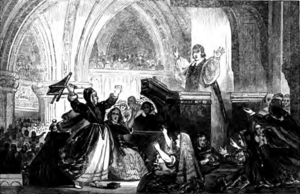Jenny Geddes facts for kids
Quick facts for kids Jenny Geddes |
|
|---|---|

Incident in St Giles' Cathedral
|
|
| Church | St. Giles' Cathedral |
| Personal details | |
| Birth name | Various names and spellings Jenny Geddes or Janot Geddes |
| Born | c. 1600 |
| Died | c. 1660 (aged 59–60) |
| Denomination | Presbyterian |
| Spouse | Robert Mean? |
Jenny Geddes (around 1600 – around 1660) was a Scottish market seller in Edinburgh. She is famous for supposedly throwing a stool at a minister. This happened in St Giles' Cathedral because she didn't like the new prayer book.
This event is said to have started a big riot. This riot then led to the Wars of the Three Kingdoms. These wars included the English Civil War.
Why the Stool Was Thrown

For many years, the Church of Scotland was set up like the Church of England. But the Scottish church was more Puritan in its beliefs and practices. In 1633, King Charles I visited St Giles' Cathedral. He had his Scottish coronation there. He used the full English church services.
The king wanted to bring Anglican-style church services to Scotland. He asked a group to create a new prayer book. In 1637, a printer in Edinburgh made this book. It was called:
The BOOKE OF Common Prayer
AND Administration Of The Sacraments:
And other parts of divine Service
for the use of the CHURCH OF SCOTLAND.
Many people in Scotland did not like these changes. They opposed the new prayer book.
The Famous Incident
The new prayer book was first used on Sunday, July 23, 1637. This was at St Giles' Cathedral. James Hannay, a church leader, began to read from it. Jenny Geddes, a market woman, then threw her stool. She aimed it right at the minister's head.
Some people say it was a folding stool. Others say it was a larger, three-legged stool. As she threw it, she reportedly shouted: "De'il gie you colic, the wame o' ye, fause thief; daur ye say Mass in my lug?" This means, "Devil give you a stomach ache, false thief; dare you say the Mass in my ear?"
This act started a huge uproar. Many people in the church began shouting. They threw Bibles, stools, sticks, and stones. Church officers tried to remove the rioters. But the rioters stayed outside. They hammered on the doors and threw stones.
More serious riots followed in the streets. The city leaders were trapped in their building. They had to talk with the angry crowd. A committee called the Tables was formed. This group was to talk with the king's advisors.
King Charles I refused to remove the new prayer book. More riots broke out. People even talked about civil war. This led to many Scots signing the National Covenant in 1638. This document showed they would not accept new church rules. They wanted changes to be approved by Parliament.
Later that year, church leaders were removed from the Church of Scotland. The church became fully Presbyterian. King Charles reacted by starting the Bishops' Wars. These wars began the larger Wars of Three Kingdoms.
It's hard to find clear proof about Jenny Geddes. Some people even wonder if she truly existed. But she is still a big part of Edinburgh's history. There is a memorial to her in St Giles' Cathedral. The sculpture shows a three-legged stool.
Around 1787, the poet Robert Burns named his horse after Jenny Geddes. He wrote fun stories about this loyal horse.
Remembering Jenny Geddes
In 1886, a special plaque was put up in St Giles' Cathedral. It honors Jenny Geddes. A kind person named Robert Halliday Gunning paid for it.
See also
- Bishops' Wars
- Book of Common Order
- Prayer Book Rebellion in the West of England
- Religion in the United Kingdom




